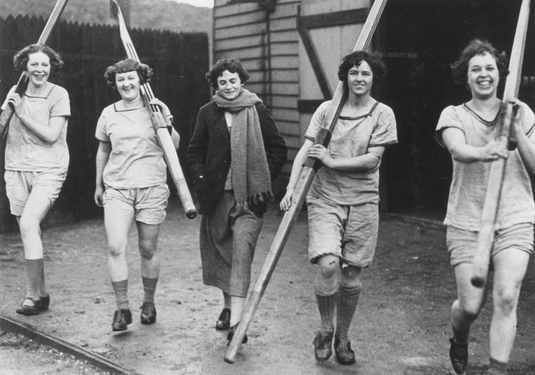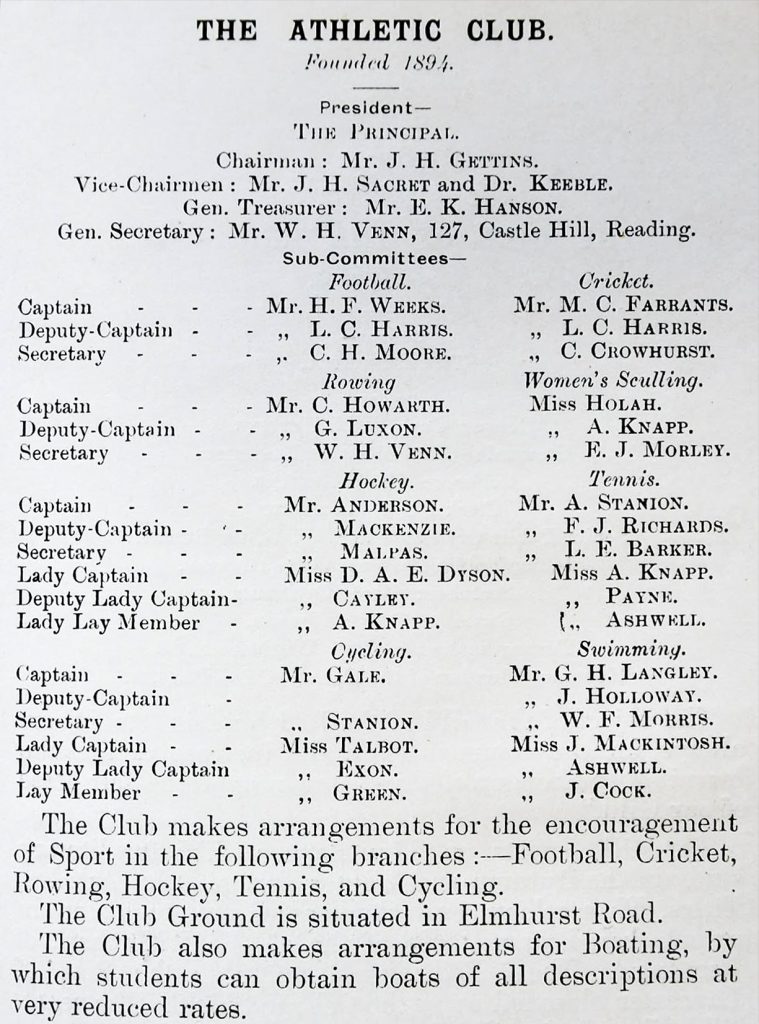The women’s FA Cup final on December 5th 2021 was a reminder that the Football Association had effectively banned women’s football a century earlier by denying access to its pitches, a ban that remained in place until 1969. Football was felt to be an unsuitable activity for females.
It was thanks to the social historian Carol Dyhouse, Emeritus Professor of History at the University of Sussex, that I became aware of a related sporting controversy at University College Reading. It concerned women and boating.
Dyhouse, who had been an undergraduate at Reading, included the College/University in her sample of higher education institutions for her book ‘No Distinction of Sex‘ (1995), an analysis of the place of women students and academic staff in British universities between 1870 and 1939. This in-depth research draws on an impressive range of sources including the archives of colleges and universities across England, Scotland and Wales.
In a section titled ‘Boat-racing, women and sport‘ (pp. 202-6), Dyhouse recounts how in 1917 W. M. Childs, Principal of University College Reading, set up a committee to investigate whether racing in boats was an appropriate activity for women students. Her account was so intriguing that I asked the Special Collections staff if they could track down the sources. Dyhouse’s original reference (Box no. 253) was no longer active but Sharon Maxwell, Archivist at MERL, discovered its location.
The first relevant document is an undated memo containing an extract from the minutes of the Academic Board of July 2 1917. It stated that a motion had been passed concerning boat racing and women students:
‘That a Committee be appointed to inquire into conditions which obtain in other colleges, as to the practice of rowing, racing and sculling, and as to the safeguards which are adopted in those Colleges in the interests of women students.‘
The Committee was to consist of:
- Edith Morley, Professor of English Language;
- Mary Bolam, Warden of St Andrew’s Hall;
- Lucy Ashcroft, Censor of Women Students.
The first step was an explanatory letter and questionnaire from Professor Childs seeking opinions from eight colleges and universities. The letter, which I referred to in my previous post about the Women’s Sculling section, worded the issue as follows:
‘The question has arisen here as to whether our women students should be allowed to have rowing races. …. This is a question which obviously is not free from difficulty and about which more than one opinion has already been expressed.‘ (Dated 19th October 1917)
Among other things, the accompanying questionnaire asked:
- whether women students were allowed to take part in rowing (as opposed to sculling or boating);
- whether they were allowed to race;
- if forbidden, for what reasons;
- if permitted, whether medical certificates, certificates of swimming proficiency or ‘a special costume’ were required;
- whether the boats had sliding seats;
- the length of the course;
- whether there were competitions against other colleges;
- whether there was any annoyance from attendance by the general public;
- and, finally, ‘whether in your opinion rowing or racing by women students is, or would be, prejudicial to health and welfare.‘
A memo from the Principal of 2nd November 1917 summarised the responses. Of the eight institutions canvassed, four were positive and four were negative.
Even those expressing positive attitudes often required safeguards such as medical inspections (Bedford College) or other knowledge of the student’s good health (Westfield College). Westfield and Bedford Colleges sculled on Regents Park Lake which was so shallow that swimming proficiency was said to be irrelevant. A positive reply was received from University College, London that concluded, ‘..there is nothing prejudicial to their health or general welfare.‘ All three of the above colleges favoured shorter courses for women.
The most reassuring reaction, however, was from Dr Aldrich Blake, Dean of the London School of Medicine who pronounced rowing healthy and harmless and suggested that rowing clubs should be trusted to decide their own regulations.
The views of those opposed to racing included:
- sculling and punting were fine, but for recreation only – attaining competitive standards would be bad for women (Royal Holloway College);
- rowing is acceptable but, ‘I am inclined to think that rowing racing might occasionally be prejudicial to the health of women students’ (the Principal of Somerville);
- rowing is allowed but, ‘racing would be prejudicial to the health and welfare of women students‘ (Lady Margaret Hall, Oxford).
Of the negative responses, a supplementary letter (see below) was returned by Sir Isambard Owen, Vice-Chancellor of Bristol University, using his status as a physician to reinforce his opinion that female students should not be racing in boats.

At this point, the papers from 1917 concluded without any indication of the final outcome (no doubt a record exists somewhere but I haven’t found it). Nevertheless, if we jump to 1921, a letter to the Principal from an E. Verity, Secretary of the Women’s Sculling Section, provides some clues. In it she requests ‘permission for us to include racing amongst the other activities of the section.’ The key section is as follows:
‘We understand that in 1917 this was refused by the Academic Board but we beg to ask that this decision be reconsidered. We are not aware of the grounds upon which the previous refusal was based….‘ (Dated 28th February 1921)
The letter produced an unambiguous result: two months later a memo was circulated headed ‘Boat Racing for Women Students. Regulations of the Academic Board.‘ Written in pencil on the copy in the Special Collections is, ‘Copy sent to Miss Verity‘. The requirements in brief were these:
- A medical certificate attesting fitness for such exercise.
- Written permission from parents or guardian.
- Competing against a male crew was forbidden.
- The racing course for women should be no longer than half a mile.
- The certificate and written permission were to be submitted to the Censor of Women Students (Lucy Ashcroft) who would notify the relevant hall wardens.
These regulations, formulated during the era of the University College, were still in place after the Charter had been granted. Thus in 1931 Franklin Sibly, who had succeeded Childs as Vice-Chancellor, felt obliged to remind women boaters of the first two rules in a memo addressed to the Secretary of the Women’s Sculling and Rowing clubs and copied to the wardens of women’s halls. According to the final paragraph:
‘These conditions must be strictly observed. The rowing and sculling captains in each Hall will in future be responsible for collecting the certificates and permissions, and for handing them to the Warden of the Hall.‘ (Dated 11th November 1931)
The suggestion of hall teams in this extract is reveaIing. I don’t know when inter-hall competition started, but the image below of the St David’s crew shows that it was in place by 1924. According to Smith and Bott’s pictorial history of university education at Reading, St David’s were narrowly defeated on this occasion by Wessex Hall in the final of the Challenge Fours.

SOURCES
Dyhouse, C. (1995). No distinction of sex? Women in British universities, 1870-1939. London: UCL Press.
Smith, S. & Bott, M. (1992). One hundred years of university education in Reading: a pictorial history. Reading: University of Reading.
University of Reading Special Collections, Uncatalogued papers, Reference UHC AA-SA 8.


